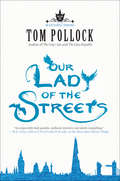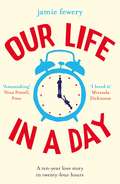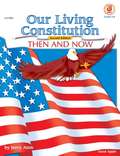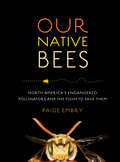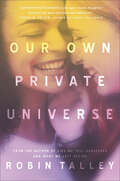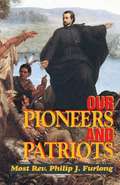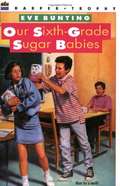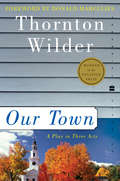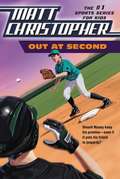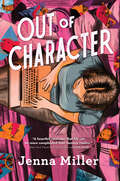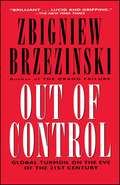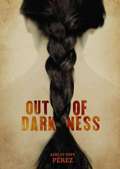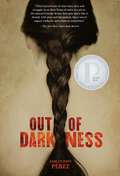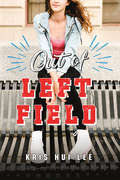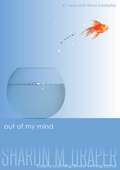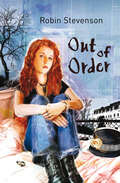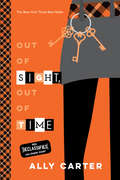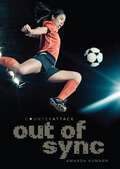- Table View
- List View
Our Independence and the Constitution
by Dorothy Canfield FisherThe book portrays the writing of the Declaration of Independence and the formation of the Constitution through the eyes of one Philadelphia family.
Our Lady of the Streets (Skyscraper Throne Ser. #3)
by Tom PollockEver since Beth Bradley found her way into a hidden London, the presence of its ruthless goddess, Mater Viae, has lurked in the background. Now Mater Viae has returned with deadly consequences. Streets are wrecked by convulsions as muscles of wire and pipe go into spasm, bunching the city into a crippled new geography; pavements flare to thousand-degree fevers, incinerating pedestrians; and towers fall, their foundations decayed. As the city sickens, so does Beth--her essence now part of this secret London. But when it is revealed that Mater Viae's plans for dominion stretch far beyond the borders of the city, Beth must make a choice: flee, or sacrifice her city in order to save it.
Our Life in a Day: The uplifting and heartbreaking love story you won't want to miss
by Jamie Fewery'Oh my heart. I absolutely loved this book' - Netgalley reviewerA ten-year love story in twenty-four hours - for fans of One Day by David Nicholls, The Perks of Being a Wallflower by Stephen Chbosky, and The Note by Zoe Folbigg.The rules are simple.Choose the most significant moments from your relationship - one for each hour in the day.You'd probably pick when you first met, right? And the instant you knew for sure it was love? Maybe even the time you watched the sunrise after your first night together?But what about the car journey on the holiday where everything started to go wrong? Or your first proper fight?Or that time you lied about where you'd been?It's a once in a lifetime chance to learn the truth. But if you had to be completely honest with the one you love, would you still play?For Esme and Tom, the game is about to begin. And once they start, there's no going back . . .*************What readers are saying about Our Life in a Day:'A great portrayal of mental illness... A quite brilliant book''Explores depression, the spiral of addiction and the impact that mental illness has in those closest''I could have gone on reading about Esme and Tom forever''Oh my heart... I loved every page'
Our Living Constitution: Then and Now
by Jerry AtenThis book was written to more easily pass on the rich and timeless message of the U.S. Constitution and to demonstrate how it serves us today. Easy-to-use, it makes the legalistic language and complex structure of the document accessible for all students. Using a unique, two-column format, the full text of the Constitution is presented beside an explanation of its meaning in terms students will understand. Divided into lessons of varying length, it includes thought-provoking questions and directives for outside work. The book begins with a study of the Declaration of Independence for historical perspective.
Our Native Bees: North America's Endangered Pollinators and the Fight to Save Them
by Paige Embry"Captures the essence of a bee’s natural history and how we use (and sometimes abuse) bees.” —Olivia Messinger Carril, author of The Bees in Your Backyard Honey bees get all the press, but the fascinating story of North America’s native bees—an endangered species essential to our ecosystems and food supplies—is just as crucial. Through interviews with farmers, gardeners, scientists, and bee experts, Our Native Bees explores the importance of native bees and focuses on why they play a key role in gardening and agriculture. The people and stories are compelling: Paige Embry goes on a bee hunt with the world expert on the likely extinct Franklin’s bumble bee, raises blue orchard bees in her refrigerator, and learns about an organization that turns the out-of-play areas in golf courses into pollinator habitats. Our Native Bees is a fascinating, must-read for fans of natural history and science and anyone curious about bees.
Our Own Private Universe
by Robin TalleyFifteen-year-old Aki Simon has a theory. And it's mostly about sex. No, it isn't that kind of theory. Aki already knows she's bisexual-even if, until now, it's mostly been in the hypothetical sense. Aki has dated only guys so far, and her best friend, Lori, is the only person who knows she likes girls, too. Actually, Aki's theory is that she's got only one shot at living an interesting life-and that means she's got to stop sitting around and thinking so much. It's time for her to actually do something. Or at least try. So when Aki and Lori set off on a church youth-group trip to a small Mexican town for the summer and Aki meets Christa-slightly older, far more experienced-it seems her theory is prime for the testing. But it's not going to be easy. For one thing, how exactly do two girls have sex, anyway? And more important, how can you tell if you're in love? It's going to be a summer of testing theories-and the result may just be love.
Our Pioneers and Patriots
by Philip J. FurlongA famous 5th-8th grade American history textbook written in 1940 with Catholic faith and patriotic love of country. From early exploration and settlement through the 20th century.
Our Sixth Grade Sugar Babies
by Eve BuntingVicki Charlip and her friend Ellie are humiliated! Their sixth-grade teacher, Mrs. Oda, says each of her students must dress a five-pound bag of sugar in baby's clothes and carry it around. For a whole week they must never leave their sugar babies alone. It will teach them responsibility. "How will you know if we cheat?" Horrible Harry Hogan asks. "I'm putting you on your honor," Mrs. Oda says. Vicki is sure Horrible Harry will cheat, but of course she won't. But then a gorgeous seventh-grade boy moves in across the street, and Vicki is embarrassed to have HIM see her carrying around a silly-looking sugar baby. One deception leads to another when Vicki abandons her baby temporarily, and the baby vanishes. Horrors! Has it been stolen and turned into cookies? Or worse, into fudge? It is not, however, until there is another disappearance and a near-tragedy that Vicki learns the true meaning of responsibility... and honor.
Our Town: A Play in Three Acts (Harper Perennial Modern Thought Ser.)
by Thornton WilderOur Town was first produced and published in 1938 to wide acclaim. This Pulitzer Prize-winning drama of life in the town of Grover 's Corners, an allegorical representation of all life, has become a classic. It is Thornton Wilder's most renowned and most frequently performed play. It is now reissued in this handsome hardcover edition, featuring a new Foreword by Donald Margulies, who writes, "You are holding in your hands a great American play. Possibly the great American play. " In addition, Tappan Wilder has written an eye-opening new Afterword, which includes Thornton Wilder's unpublished notes and other illuminating photographs and documentary material.
Our World: Ancient World Cultures
by Lisa Arnold Barbara Brown Leslie SwensonNIMAC-sourced textbook
Out At Second (Matt Christopher: The #1 Sports Series for Kids)
by Matt ChristopherShould Manny keep his promise-even if it puts his friend in danger? When the Grizzlies' first basemen is sidelined two days before the playoffs, catcher Manny Griffin and second baseman Stu Fletcher take it upon themselves to help his replacement become a better player. The three practice together and all is going well-until a wild throw hits Stu right in the head! Manny gives his word to keep quiet, but a few days later, Stu starts acting funny. Now Manny faces a difficult decision: should he break his promise and let Stu and the team down... or keep silent and hope that he's not putting Stu in danger?
Out of Character
by Jenna MillerDumplin’ meets Geekerella in debut author Jenna Miller’s queer, body-positive love story that explores online and offline relationships in all of their messiness.If you asked seventeen-year-old Cass Williams to describe herself, she’d happily tell you she’s fat, a lesbian, and obsessed with the Tide Wars books. What she won’t tell you—or anyone in her life—is that she’s part of an online Tide Wars roleplay community. Sure, it’s nerdy as hell, but when she’s behind the screen writing scenes as Captain Aresha, she doesn’t have to think about her mother who walked out or how unexpectedly stressful it is dating resident cool girl Taylor Cooper.But secretly retreating to her online life is starting to catch up with Cass. For one, no one in her real life knows her secret roleplay addiction is the reason her grades have taken a big hit. Also? Cass has started catching feelings for Rowan Davies, her internet bestie . . . and Taylor might be catching on.As Cass’s lies continue to build, so does her anxiety. Roleplaying used to be the one place she could escape to, but this double life and offline-online love triangle have only made things worse. Cass must decide what to do—be honest and risk losing her safe space or keep it a secret and put everything else on the line.
Out of Control
by Sarah AldersonFrom the highly-acclaimed, award-winning author of Hunting Lila comes a thrilling romance with a dark reality at it's heart.<P> When 17-year old Liva witnesses a brutal murder she's taken into police custody for her own protection. But when bullets start flying, it becomes clear that Liva is not just a witness, she's a target.<P> Together with a car thief called Jay, Liva manages to escape the massacre - but now the two of them are alone in New York, trying to outrun two killers who will stop at nothing to find them.<P> When you live on the edge, there's a long way to fall.
Out of Control (Travel Team Series)
by Rick JasperWhen Trip decides to take a break from baseball to focus on his own music, his father loses his temper. He threatens to stop donating money to the team. Will the Roadrunners survive losing their biggest financial backer and their star shortstop? Will Trip have the courage to follow his dreams, and not his father's?
Out of Control (Travel Team)
by Richard ReeceCarlos "Trip" Costas is a fiery shortstop with many talents and passions. His father is Julio Costas—yes, the Julio Costas, the famous singer. Unfortunately, Julio is also famous for being loud, controlling, and sometimes violent with Trip. He dreams of seeing his son play in the majors, but that's not what Trip wants. When Trip decides to take a break from baseball to focus on his own music, his father loses his temper. He threatens to stop donating money to the team. Will the Roadrunners survive losing their biggest financial backer and their star shortstop? Will Trip have the courage to follow his dreams, and not his father's?
Out of Darkness
by Ashley Hope PérezSet against the back drop of one of the worst school tragedies in American history, Out of Darkness is a brutal and gripping novel about race, segregation, love, and the forces that destroy people.
Out of Darkness
by Ashley Hope PérezA Michael L. Printz Honor Book "This is East Texas, and there's lines. Lines you cross, lines you don't cross. That clear?" New London, Texas. 1937. Naomi Vargas and Wash Fuller know about the lines in East Texas as well as anyone. They know the signs that mark them. They know the people who enforce them. But sometimes the attraction between two people is so powerful it breaks through even the most entrenched color lines. And the consequences can be explosive. Ashley Hope Pérez takes the facts of the 1937 New London school explosion—the worst school disaster in American history—as a backdrop for a riveting novel about segregation, love, family, and the forces that destroy people. "[This] layered tale of color lines, love and struggle in an East Texas oil town is a pit-in-the-stomach family drama that goes down like it should, with pain and fascination, like a mix of sugary medicine and artisanal moonshine."—The New York Times Book Review "Pérez deftly weaves [an] unflinchingly intense narrative....A powerful, layered tale of forbidden love in times of unrelenting racism."―starred, Kirkus Reviews "This book presents a range of human nature, from kindness and love to acts of racial and sexual violence. The work resonates with fear, hope, love, and the importance of memory....Set against the backdrop of an actual historical event, Pérez...gives voice to many long-omitted facets of U.S. history."―starred, School Library Journal
Out of Left Field
by Kris Hui LeeThere's no playing it safe in love or baseball in this sparkling debut, perfect for fans of Morgan Matson and Kasie West. Marnie has never had a hard time fitting in with the guys. It would take a lot more than their goofy antics to keep her from joining them at the neighborhood sandlot to do what she loves best: play ball.An added perk of hanging out at the sandlot? Spending time with Cody Kinski, their high school's star pitcher and Marnie's best friend. Sure, he can be stubborn and annoying. He also knows how to make her laugh and respects her skills on the field. And when he gets nailed in the arm by a bone-fracturing pitch, Marnie becomes the team's best chance at making it to the playoffs. Except no one told the guys they're supposed to be on her side. With her own team against her, Marnie begins questioning her abilities. And when fate throws her a curveball, can she play without losing the game, Cody, and her belief in herself?
Out of My Dreams (The Out of My Mind Series)
by Sharon M. DraperMelody flies to London to speak at a convention about differently abled kids in this &“warm and beautifully told&” (Kirkus Reviews, starred review) sequel to the acclaimed, New York Times bestselling middle grade novels Out of My Mind and Out of My Heart.When Melody saves an elderly back-in-the-day actress&’s life, she ends up on their local TV channel. The studio is so impressed with Melody that they arrange for her to be a speaker at an international symposium for kids who are differently abled, and this year&’s symposium is in London! To Melody&’s utter shock and delight, her parents say yes. Yes! Melody finally gets to fly on an airplane, and many adventures in London await, including a cheeky interaction with a royal guard&’s horse, becoming a little too acquainted with old-timey armor, and a run in with one of the most popular pop stars on the planet! But the biggest adventure is the I.D.E.A. symposium. There, Melody meets kids from all over the world who are rallying for greater accessibility and more thoughtful planning on how to make the world more equal for every kid, no matter the challenges they face. But as Melody&’s time to speak approaches, big-time nerves set in: how can a girl who&’s never spoken a word out loud in her life give an entire speech?
Out of My Heart (The Out of My Mind Series)
by Sharon M. DraperA New York Times bestseller! Melody faces her fears to follow her passion in this stunning sequel to the acclaimed, New York Times bestselling middle grade novel Out of My Mind.Melody, the huge-hearted heroine of Out of My Mind, is a year older, and a year braver. And now with her Medi-talker, she feels nothing&’s out of her reach, not even summer camp. There have to be camps for differently-abled kids like her, and she&’s going to sleuth one out. A place where she can trek through a forest, fly on a zip line, and even ride on a horse! A place where maybe she really can finally make a real friend, make her own decisions, and even do things on her own—the dream! By the light of flickering campfires and the power of thunderstorms, through the terror of unexpected creatures in cabins and the first sparkle of a crush, Melody&’s about to discover how brave and strong she really is.
Out of My Mind (The Out of My Mind Series)
by Sharon M. DraperThis special movie tie-in edition showcases a new cover with an image from the original movie now available on Disney+! A New York Times bestseller for three years and counting! &“Unflinching and realistic.&” —Kirkus Reviews (starred review) From award-winning author Sharon Draper comes a &“gutsy, candid, and compelling&” (School Library Journal, starred review) story that will forever change how we all look at anyone with a disability, perfect for fans of RJ Palacio&’s Wonder.Eleven-year-old Melody is not like most people. She can&’t walk. She can&’t talk. She can&’t write. All because she has cerebral palsy. But she also has a photographic memory; she can remember every detail of everything she has ever experienced. She&’s the smartest kid in her whole school, but NO ONE knows it. Most people—her teachers, her doctors, her classmates—dismiss her as mentally challenged because she can&’t tell them otherwise. But Melody refuses to be defined by her disability. And she&’s determined to let everyone know it…somehow.
Out of Order
by Robin StevensonFifteen-year-old Sophie sees her move to Victoria as a chance to start over and leave her old self behind. She is soon drawn into the orbit of the charismatic but troubled Zelia. As their friendship develops, and Zelia's behavior becomes increasingly self-destructive, Sophie struggles to maintain both the friendship and her own sense of self. Then Sophie meets Max. At first, Max seems to be Zelia's opposite: direct, straightforward and sure of herself. But this new friendship brings its own unexpected challenges and confusion, and Sophie slowly starts to realize that friendships are a place in which one can both lose and discover oneself.
Out of Sight, Out of Time (Gallagher Girls #5)
by Ally CarterFriendship. Romance. Espionage. The Gallagher Academy for Exceptional Young Women is no ordinary boarding school. Don't miss a moment of the New York Times bestselling series--now with a bonus epilogue!The last thing Cammie Morgan remembers is leaving the Gallagher Academy to protect her friends and family from the Circle of Cavan-an ancient terrorist organization that has been hunting her for over a year. But when Cammie wakes up in an alpine convent and discovers that months have passed, she must face the fact that her memory is now a black hole. The only traces left of Cammie's summer vacation are the bruises on her body and the dirt under her nails, and all she wants is to go home.Once she returns to school, however, Cammie realizes that even the Gallagher Academy now holds more questions than answers. Cammie, her friends, and mysterious spy-guy Zach must face their most difficult challenge yet as they travel to the other side of the world, hoping to piece together the clues that Cammie left behind. It's a race against time. The Circle is hot on their trail and willing stop at nothing to prevent Cammie from remembering what she did last summer.
Out of Step
by Nikki Anne SchmutzGraced with the instinctive ability to dance, Jenny Thomas wants nothing more than to become a professional dancer. All of her hard work pays off when she is accepted to a prominent dance program in New York. Against her mother’s will, but with the support of her father Jenny leaves her small Mormon town in Utah and heads to New York in pursuit of her dream. Jenny soon finds herself financially broke and spiritually lost in her new surroundings. She quickly makes friends with Paul Taylor, a witty Mormon student filmmaker who finds Jenny’s ambitious dream to be the subject for his next film project. Keeping her mind diligently focused on dance proves harder than she expected as she finds herself falling in love with David Schrader, a dark and mysterious New York musician. As their relationship builds Jenny starts to struggle in her religious beliefs and her new lifestyle. Paul's true romantic feelings soon surface and Jenny finds things to be a little more than she can handle. Her scholarship and her dreams are on the line and Jenny takes an emotional rollercoaster ride on the path to work it out. Jenny must fight to earn her scholarship and try to find a balance between the man of her faith and the man of her dreams. "Out of Step” is a powerful story of finding out what you truly believe in life and standing up for it no matter the cost. You won’t want to miss this heart gripping journey from the author of the novel “Found”. About the Author Nikki Anne Schmutz has written several screenplays, including co-writing “Out of Step" the movie. This is her second novel. She lives in Orem, Utah with her husband and two children, where she is currently working on her next novel.
Out of Sync (Counterattack)
by Amanda HumannSince they were six-year-olds, Madison and Dayton have had soccer sync. Maddie doesn't have to see her best friend on the field to know where she'll be. Her passes to Dayton are perfect, as if the two of them can read each other's mind. Together, they're a scoring machine. There's only one problem: lately, Dayton seems more interested in partying than playing soccer. And Dayton's change of heart couldn't have come at a worse time. Now that she and Maddie are sophomores, they have to really focus—or they'll have no chance of making it to a Division I college team. Can Maddie get through to her best friend? Or will the scoring machine break down?

